It’s now October 2009 and I’m thinking about my Son ‘Freddie’s’ Christmas present, I wanted to make him something special and came across the plans for a mini Willis Jeep at a kit car show. My mate Woot is also making one at the same time for his grand children.
The kit was purchased from a company in the UK called Toylander, their comprehensive web site www.toylander.co.uk has various plans and complete kits available for sale, I have opted to make this one from scratch and modify the spec slightly. (I’m already thinking of how to add a jet engine to it).

The start of the manufacture turned out to be a bit of an epic session, the photo above was taken about 2 hours in to the build (we started at 18:00), nice and fresh and enthusiastic.

All the parts have now been marked out as per the 1:1 scale plans provided and cut out using a jigsaw, we were pretty careful with the measurements, so we worked slowly but surely. I think it was about 23:30 at this point, starting to wilt slightly.

The cutouts were then laid upon another sheet of 12mm birch ply and drawn out, this sheet will act as the pattern for Woot’s Jeep.

The start of the assembly, what a good feeling it is to get to this stage. 20mm x 20mm planed timber is used to reinforce and connect the various panels together, the joints are screwed and glued together for strength.

Ooooooooh, its starting to look like a Jeep, it was getting quite late at this point and I had to concentrate even to do the simplest of things.

Maybe you can tell from my face that I was quite tired, but we had reached a good point in the build to stop. Pretty glad really as it was approaching 03:00. Time for bed.

Another nights work and then there were two.

Now for a little bit of metalwork, be purchased some scraps of 1.2mm aluminium so that we can make the wheel arch’s and wings. This proved to be quite a time consuming task, the first wheel arch took about twice as long as the second, but of course we new what we were doing then.

Because of the initial haste of gluing all the wooden parts together, when it came to fixing the wheel arch’s in to place, it became apparent that the bonnet cross beams are only secured after the wheel arch’s have bee secured due to the restriction in getting the pop riveter in place, because of this we had to make a fold of the aluminium and rivet in place from the side, no big issue really.

For all of the aluminium to wooden joints we made good use of black PU adhesive, this stuff is extra double strong, flexible and relatively cheap at the same time.

A view of the wheel arch’s from the inside of the Jeep.

Now for the wings. Aluminium panels were cut to size and an approximate bend was induced by rolling the aluminium over a fire extinguisher.

The holes were pre drilled in the metal and the inside edges roughed up a little so that the PU glue had a key to stick to.
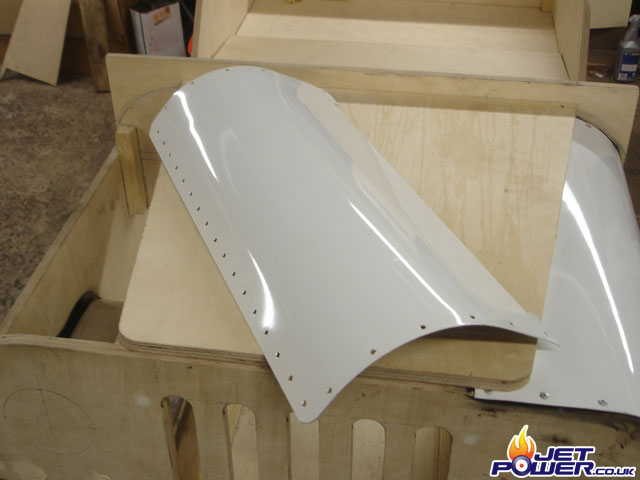
Aluminium wing number one fixed in to place.

This picture shows Woot securing the (optional extra) mud guards in to place. He makes use of his Leatherman utility knife thingy at all times (Not Shown).

Far to early for a coat of paint, but we couldn’t resist, a decision has still yet to be made about the choice of paint to cover the aluminium parts. We used Khaki silk paint for the body’s (emulsion), this seems to be a good choice of colour.

I popped down to my local automotive supplier to find a custom colour matched aerosol for the metal bits; Unfortunately once applied it was obvious that the colour did not match particularly well and the decision was made to prime the aluminium and paint over with emulsion. This is not an ideal solution, but touching up is at least easy.

Woot’s first attempt ever at welding and what a fine job he did of it as well.
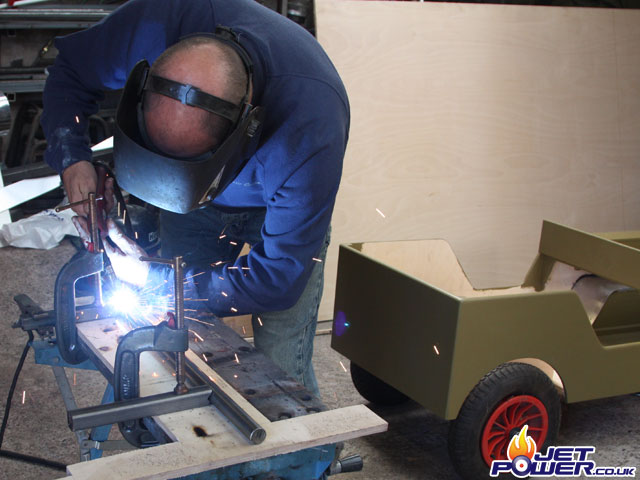
Can’t seem to stop him now.

My rear axle secured in to place using 6mm bolts.

The metal fixing plates above the axle.

I decided that a fixed axle would be of no use to us as the Toylander will be used mainly in the field at the back of the house and would likely get stuck in the unevenness of it all. Thus a pivoting axle design has been implemented.

The stub axles consists of 24mm threaded bar for the pivoting action and 25mm solid bright bar for the wheels to attach to.

The wheel’s were ordered from Toylander, we admittedly looked around for cheaper variants, but when it came to it, the originals looked the best and offered best value for money.

A stubb was fabricated and attached to the rear of the Geepstar, this gives an excellent place for the spare wheel to be attached. If your picky the spare was always on the right hand side of the original Willys, but this version is going to be R/H drive, we are in the UK you know!

We used 8mm Go-Kart ball joints for the steering linkage. There is a fair bit of play in the stub axle movement, so the addition of the ball joints will make sure the play is kept to a minimum.

A basic T bracket was made to hold the Jerry Can in place, 1″ flat bar was used for this.

Then four brackets were welded up and attached to the Geepstar. These are to hold two british army 58 pattern kidney pouches (They come as a pair) on each side.

The front bumper was quick and easy to make, and just bolted to the underside of the Geepstar.

Cooling for the drive motors is important and for this purpose I purchased from ‘Salop Music‘ a 1U rack mount cooling insert.
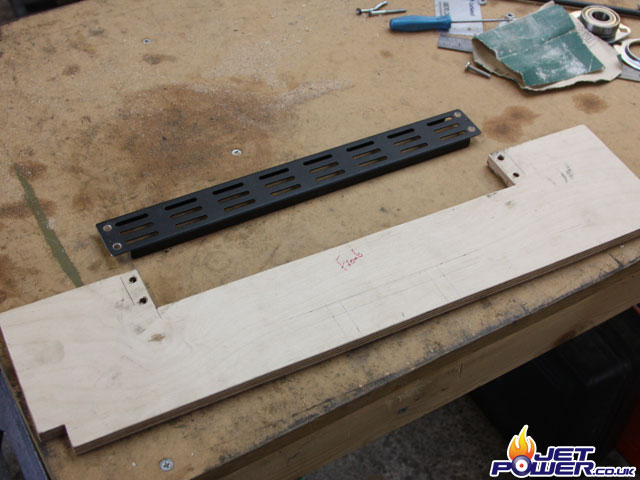
I have chosen to significantly upgrade the recommended drive motors to 24 volt electric wheel chair motors, lots of torque and built in electronic brakes!

The seating bulkhead has now had the cable tunnel hole added and the cooling vent secured with M5 bolts and Tee Nuts.

The cable tunnel that will house the power cables from the battery’s to the speed controller and motors.

This shows the basic front bulkhead, holes for the steering column have yet to be cut out.

Bulkhead and cable tunnel mounted in to place.

On the plans supplied by ‘Real Life Toys’ the rear lights are mounted on to the back panel of the Geepstar, as we have added a spare wheel and a fuel tank, there is no room, so our only choice was to mount them underneath. We have used 12/24 volt LED lights that came supplied with flexible mounting brackets.

12 volts added and hey presto! I think they will do nicely.

For the windscreen, which I guess will actually spend most of it’s time folded down we are using 12mm birch ply.

The windscreen held in place by my grandfather, no sorry my mistake, Wootton. All I need to do now is Route out the inside of the screen area so that some Plexi Glass can be easily secured in to place.

The holes for the front lights were cut out using a adjustable hole cutter, yes I know, this would have been easier if they had of been cut out before the wood work was assembled. We then used a Router to add a nice curve to the inside edge.

A second piece of ply was cut out and screwed and glued in to place behind the front grille to add depth to the lights. Small aluminium tabs were then attached as a means of securing the lamps.
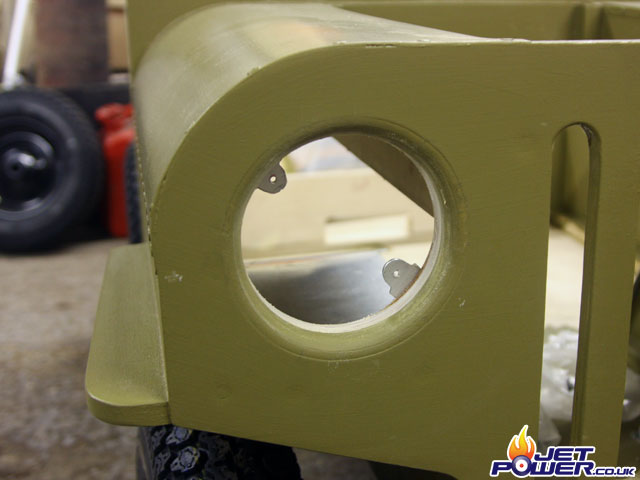
Let there be light and there was light! As the Geepstar will be running on 24 Volts, the 12 Volt electronic components will be wired in series.

The motor mounting bracket is made from 75mm angle & 5mm thick, a section was cut away for shaft clearance and holes drilled for the motor bolts. More holes will be added as a means of adjusting the chain tension in the near future.

The motors mounted and 24 tooth sprockets fitted. The speed controller should fit nicely in between the two motors giving clear access to the centre tunnel.

The wheelchair motors have a drive disengage feature (Handy if you have to push the Geepstar if you have a flat battery) by turning the respective levers 90 degrees, these just poke through the seat base.

I have tried a few versions of the steering wheel, and have settled upon a twin layered birch ply version as above.

Layer one cut out, now for the base layer.

The two layers were then glued together using PVA and pressed together overnight to fix. The centre hole was drilled and using a 12mm bolt attached to a pillar drill, this allowed the wheel to be planed to a perfect circle, this then paved the way for some quality routing.

The picture above shows the routed steering wheel. Fine sandpaper was used to get a smooth finish and all it needs now is to be stained to bring out the birch ply colour’s.

THis shows the start of the windscreen hinge assembly. 1 inch angle and flat bar was used.
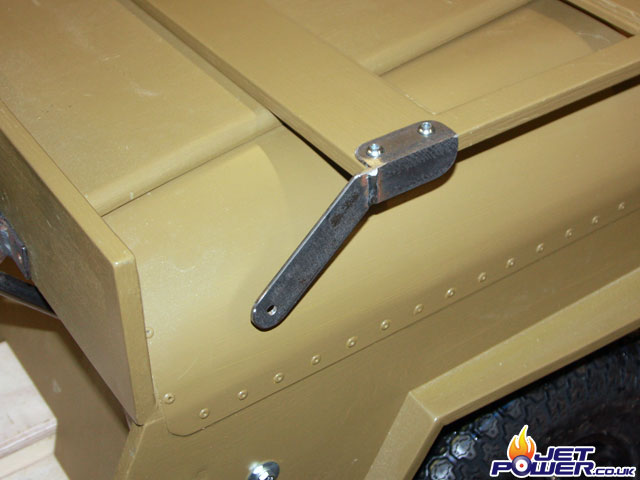
Triangular support mounts were made as per the instructions and then clamps added to hold the windscreen in the up position.

Windscreen up.
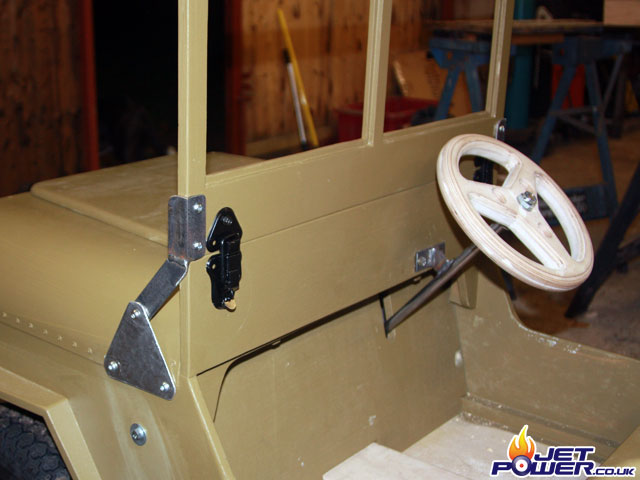
Windscreen down.

The driven sprockets have been bored out to accept a needle roller bearing and a seal on the outer face.

Checking that the appropriate size chain has been cut to length correctly and end stop washers welded on to the axle.

Then the collar was welded on to the rear wheel.
A 1″ shaft was in place to make sure everything lined up correctly.

I have chosen to use a 4qd Pro120 speed controller for the Geepstar, it’s very well made and has an abundance of features, a truly excellent piece of kit. On the downside 4qd’s communication is very poor and at times I had no idea as to the status of my orders that were placed with them and sometimes if they had even received them! Maybe it’s just because it’s a busy time for them.

Now we are at a point in the build to start thinking about the stickers, I dusted off my Vinyl Cutter and started the design process.

One of the first stickers that were made was Freddie’s number plate, a UK legal number plate font was used.

The forward and reverse lever was a bit of a challenge, but I think we have got it about right, a kitchen door knob from B&Q was cut down and used as the gear lever knob.

For the F/R switching a DPDT switch has been used, one side of the switch is used for the 4qd speed controller and the other side to illuminate an LED to indicate reverse has been selected.

This shows the wiring nearing completion, the black box to the right is a automotive remote control, should Fred be heading out of control towards my wife’s new car, with a press of the key fob he will be stopped in his tracks and a divorce will be avoided.

Anodised alloy mesh attached to a piece of ply painted with black board paint are the foundations of the bonnet grill.

Grill fixed in to place, due to the time constraints I couldn’t find any natural aluminium coloured material so I had to settle for gold, so its now a posh Geep!

Anne from ‘Green Gorse Saddlery’ provided and sewed the leather upholstery for us, underneath there is a 1″ foam layer fixed to a piece of 12mm birch plywood. The ply has two ‘Captivated Nuts’ as Woot calls them to secure them to the Geep.

Anne also very kindly made the leather gear stick gator’s and a pair of car mats were cut up for use as the Geepstar mats.

Folding shovel brackets fabricated, painted and attached. Two additional handles are attached on both sides.

Throttle pedal assembly made and installed, this was a close one as we didn’t expect the potentiometer to arrive before christmas, I suppose the 22nd December still gives us 2 days!

Weather proof protective cover made for storage outside during the summer months.

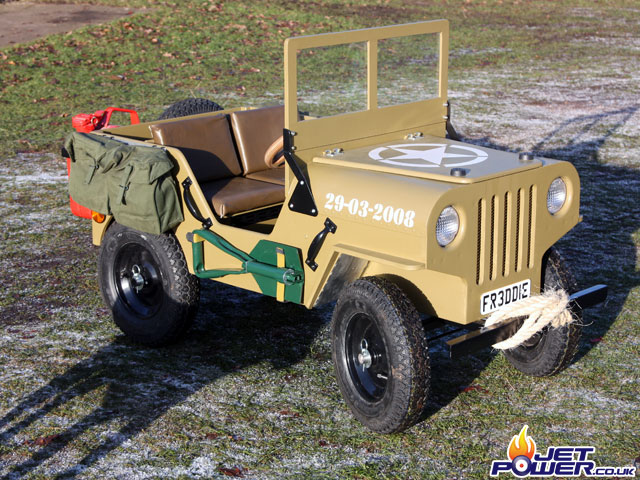













If you now look underneath the bonnet you will see a 24volt charger attached to the wing and is permanently hard wired to the battery’s. The idea being that if the Geepstar runs flat you will never be without a charger, I remember once my electric bike running flat and then the horrid feeling that you have left the charger at home.

I have now modified the front stub axles to make use of the Ackermann steering principle, I have no idea why I didn’t do this in the first place as I was totally aware of the principle behind it, possibly I was blinkered by the late nights and build instructions. The steering has now become easier to use and feels more responsive.

The front wheels greased thoroughly and carefully re tracked.

We have also had a change in the drive sprocket size, it has now gone from 24 teeth to 16 teeth, the gain has to be turned up on the speed controller to achieve the same speed, but we do get a lot more torque, over a field it feels great, but slowish on a tarmac drive, a good compromise though.
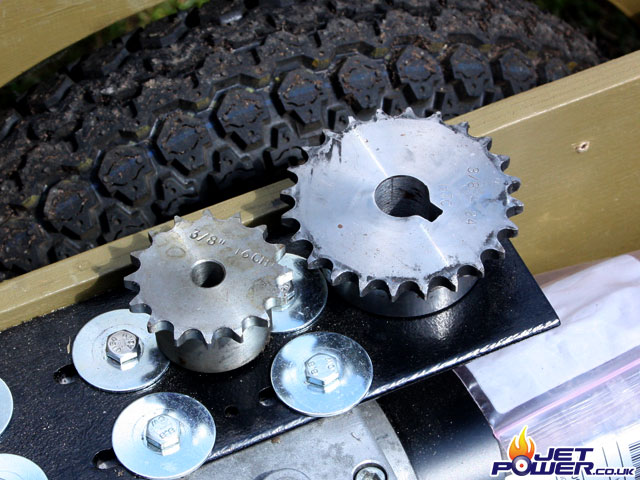
The seat can now be raised or lowered and locked in to place by two door bolts, this makes the seat adjustment and tweaks to the speed controller a lot quicker.

Fred’s cousins from Dublin, Cormac and Luke trying out the Geepstar.

Time lapse video of the initial assembly.
The first try out of the Geepstar with Will at the helm, then the man himself grandad Woot.
